Saturday 30th March 2024

I took a ride on the busy inter-urban route 100 linking Manchester and Warrington on its very last day as a commercial operation by Go North West – last Saturday, 23rd March.
The following day, Sunday, the route became part of Greater Manchester’s expanding franchised controlled Bee Network.

Buses were already beginning to appear with Bee Network vinyls crudely covering part of the company’s former logo and MCR branding,
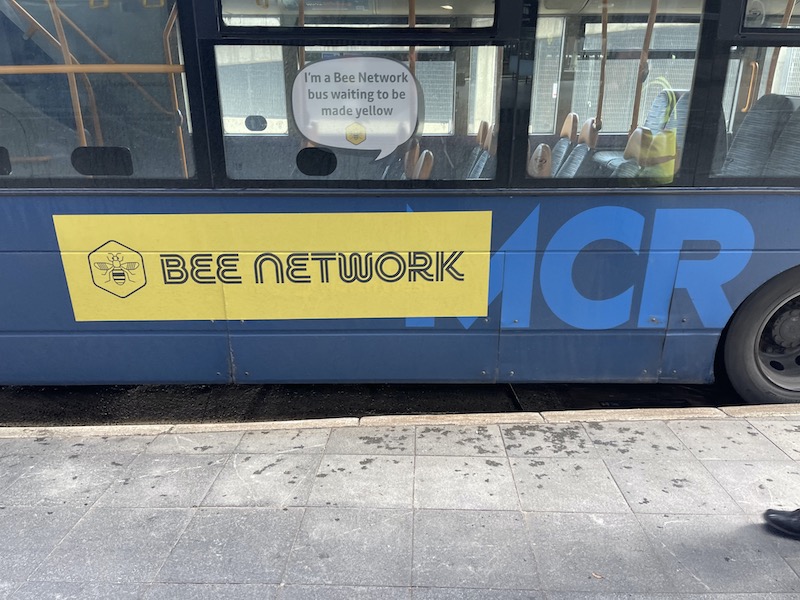
Stagecoach not only took over the buses and route from Sunday, having won the franchise from Transport for Greater Manchester (TfGM) for Tranche 2, including route 100, but also ousted Go North West from its huge Queens Road bus garage, situated just north of central Manchester.

Go North West had only taken the route and garage over from First Bus as recently as June 2019 following the latter selling up some of its Manchester operations meaning in less than four years drivers and staff at the garage are now on to their third employer.

It’s not exactly settled times for employees working for a bus company in Manchester and wanting to be loyal to their employer – but that’s franchising, Manchester style, for you.
Buses on route 100 begin their long journey across to Warrington via Salford, Eccles, Irlam, Cadishead and Hollins Green from the city’s Shudehill Interchange south of Manchester Victoria station.

TfGM has a fully staffed Travel Office within the Interchange …
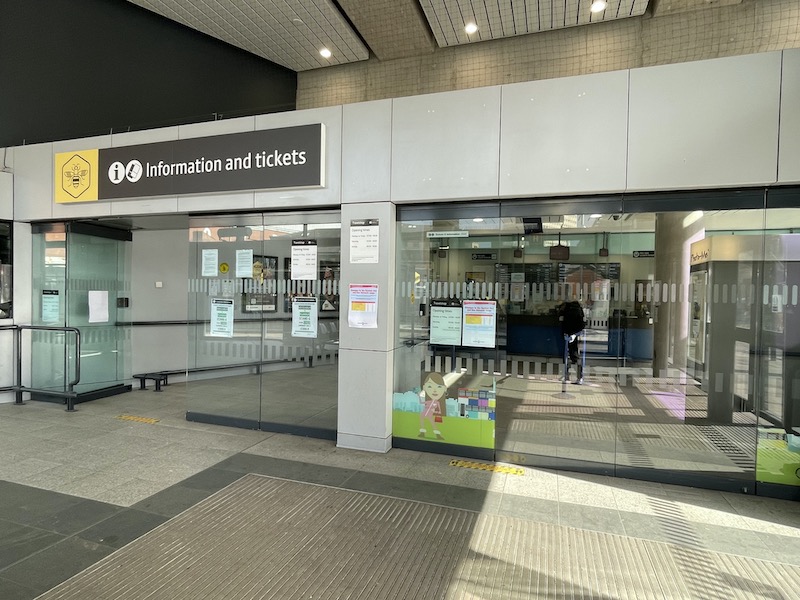
… proudly displaying a rack full of attractive looking timetable leaflets (sarcasm intended) for every route serving the city, so I eagerly picked up a copy of one for route 100 to examine the new timetable being introduced as part of the weekend’s high profile Bee Network Tranche 2 introduction.
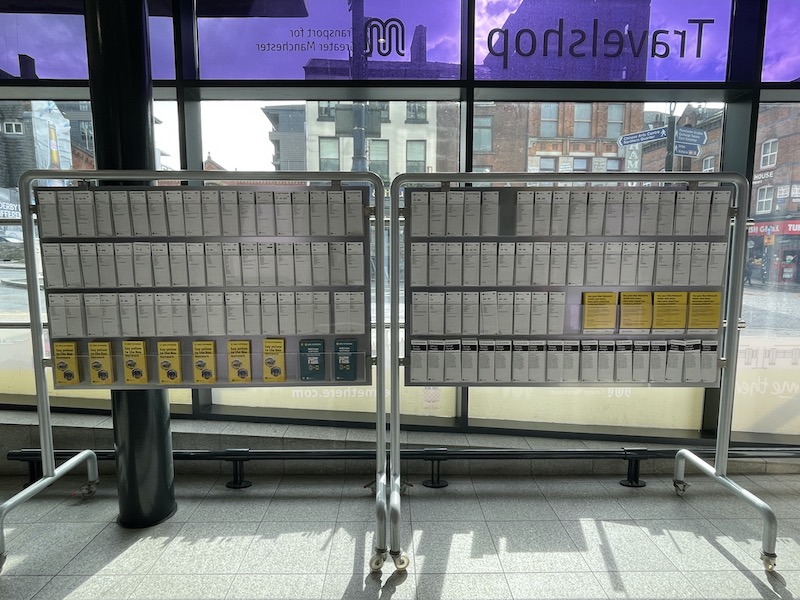
Except it was dated 23rd September 2023 and contained the about-to-expire times at midnight last Saturday. I asked at the counter if copies of the new timetable were available and the staff member had a look at piles of leaflets on a bench at the back returning to advise none were available. I asked when they’d be coming in and was told “I have no idea”.

Not a very impressive or helpful start to the new “taking back control” (and everything will be better) public sector regime.
But let’s start at the beginning as that disappointing experience was the conclusion to my Saturday morning route 100 bus riding. I’d opted to travel in an eastbound Warrington to Manchester direction to see how the route compares with the 25 other bus services belonging to the 100 Club which I’m featuring in this year’s fortnightly series.
This is one of the longest of Britain’s 26 route 100s at just over 20 miles and even breaks the two hour journey time barrier with an afternoon peak end to end time of 124 minutes. Most off peak journeys are given an hour and 53 minutes give or take a minute or two with an early Sunday morning journey taking as little as an hour and a half.
The route is in two halves very roughly equal in journey time. The western end between Warrington and the Trafford Centre – the huge out-of-town retail and leisure complex located next to the M60 orbital motorway – and between the Trafford Centre and Manchester forming the eastern end.

The timetable comprises hourly through journeys between Warrington and Manchester supplemented by hourly journeys from Hollins Green (mid way between Warrington and the Trafford Centre) giving two-an-hour on that initial section. Two more journeys per hour are added between the Trafford Centre and Manchester making for a 15 minute frequency, which until last weekend’s change had been reduced Covid/post Covid to a 20 minute frequency, with the extra journey per hour now added east of Trafford Centre.
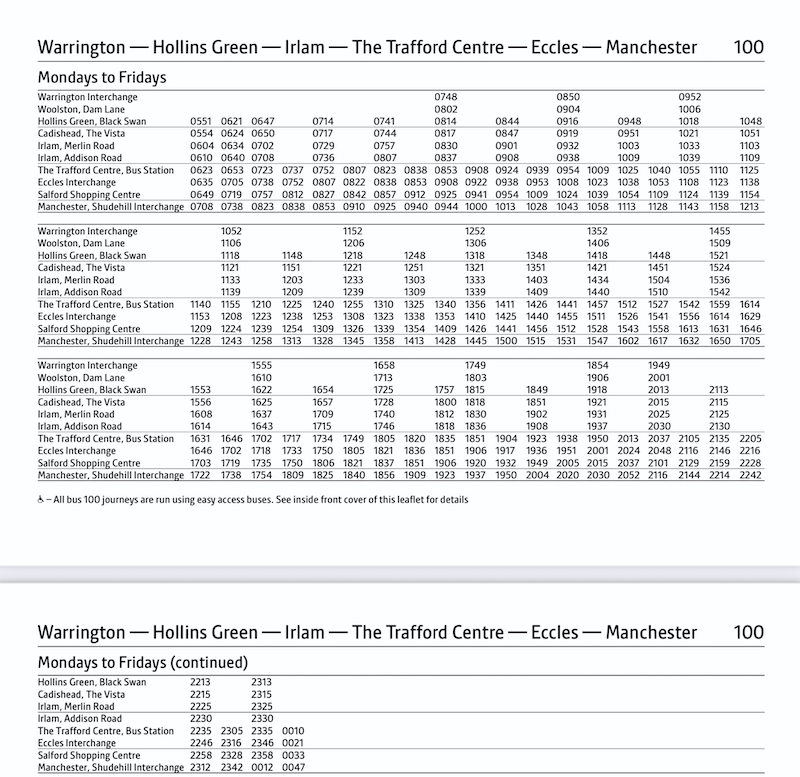
The weekday westbound timetable from Manchester spans from 05:40 to 23:25 with later starts on Saturdays (06:12) and Sundays (0745). First eastbound weekday departure from Hollins Green is 05:51 (07:34 Saturdays) and Warrington 07:48 (10:15 Sundays).
There’s no evening service beyond Hollins Green to Warrington with the last through journey from Manchester at 18:00 returning from Warrington at 19:49 (Sundays 17:35 and 19:22 respectively)
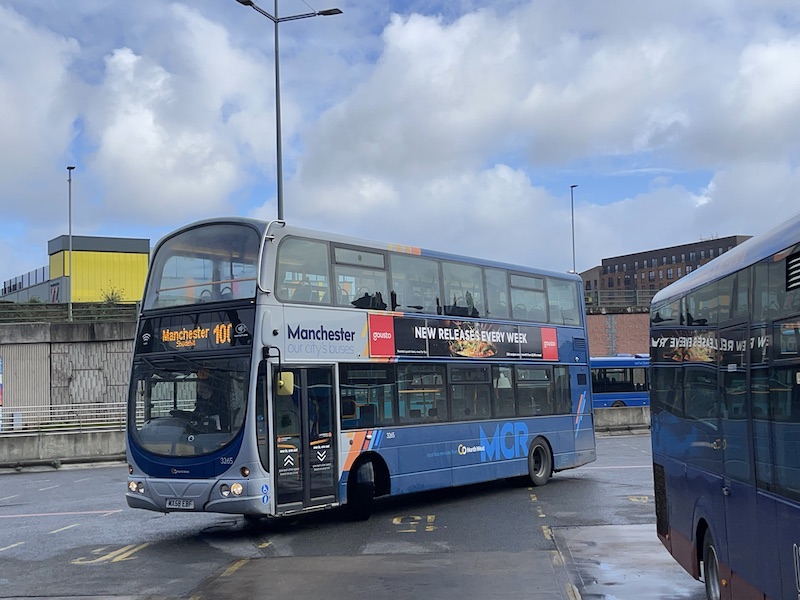
I left Warrington on what was in the old timetable a scheduled 08:55 departure. The bus had been due on its inbound journey at 08:23 but didn’t arrive into the town’s Interchange until 08:42 and as we left at 08:58 with seven on board my bus riding antennae told me something wasn’t quite right with the driver making slow progress and coming to a halt for a couple of minutes between stops as we headed out of Warrington.
Fortunately progress then returned to normal and we headed towards Hollins Green dropping a few passengers off and picking up small numbers of early morning shoppers bound for the Trafford Centre as we continued eastwards.
Leaving Warrington we passed through Paddington…

…but there was no main line terminus or Underground station to be seen, just the Banksby style illustrated, The Dog & Partridge alongside the A57.
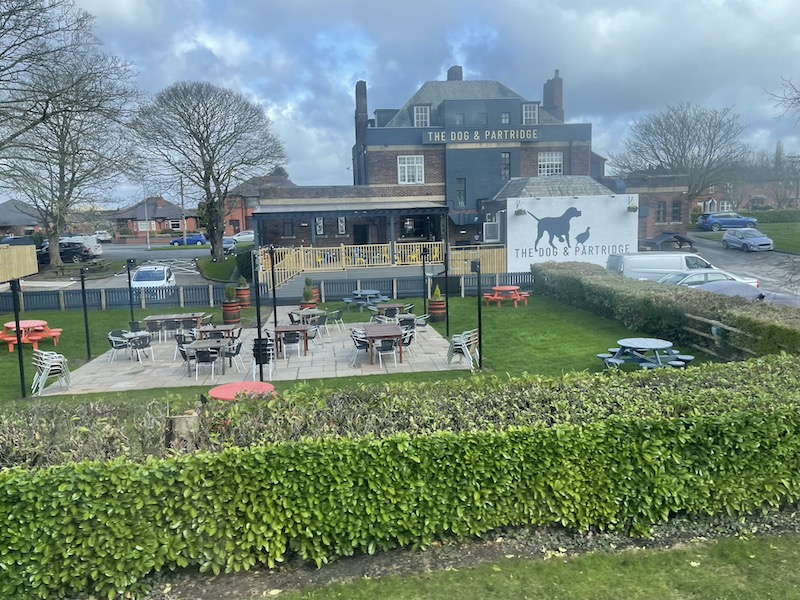
After about half an hour we were passing over the M6 and I noticed the bus following us on the schedule passed by heading towards Warrington.
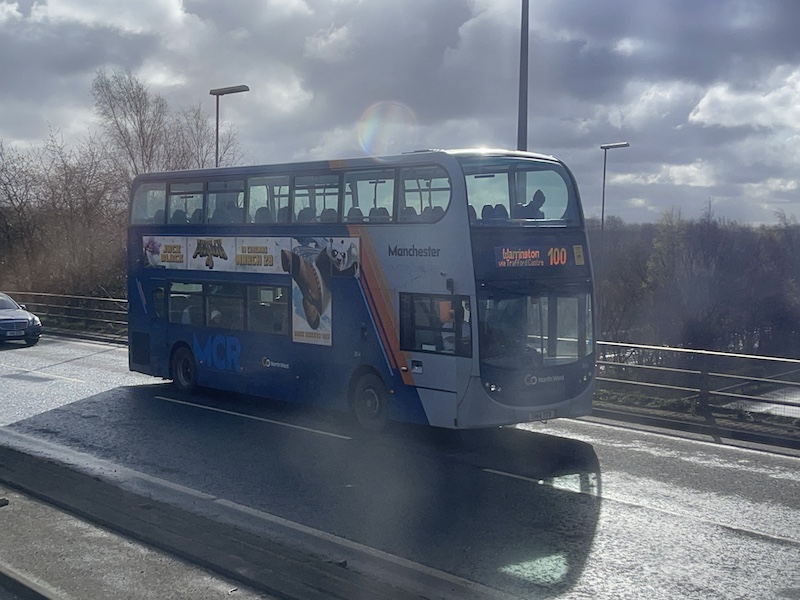
Bus stop flags were looking very unloved within Warrington Borough Council’s jurisdiction…

…but as soon as we crossed the border at Cadishead into TfGM land there was a noticeable difference including the former M logo being replaced with a new yellow corporate ‘Bus Stop’ vinyl on each and every stop together with route numbers, demonstrating what happens if you’re a ‘devolution pioneer’ blessed with millions of Government money from various funding regimes.

Before that border post we’d passed through Hollins Green where the hourly short journeys turn…

… and where there was some excitement with the closure of one carriageway on the short dual section of the A57 with 3-way temporary traffic lights at a road junction…

… leading a motorist to ignore the contra flow and head towards us on the coned off outer lane of the usual westbound carriageway.

Fortunately realisation dawned and he/she corrected their course but just like sheep was blindly followed by others making the same mistake.

From this part of the route into Manchester we’re joined by the 67 which provides an alternative 15 (was 20 until last Sunday) minute frequency into Shudehill Interchange but on a more direct route avoiding the Trafford Centre.

We’re now passing through Irlam and the bus suddenly turns left to perform a five minute deviation around a residential area abutting the M62.
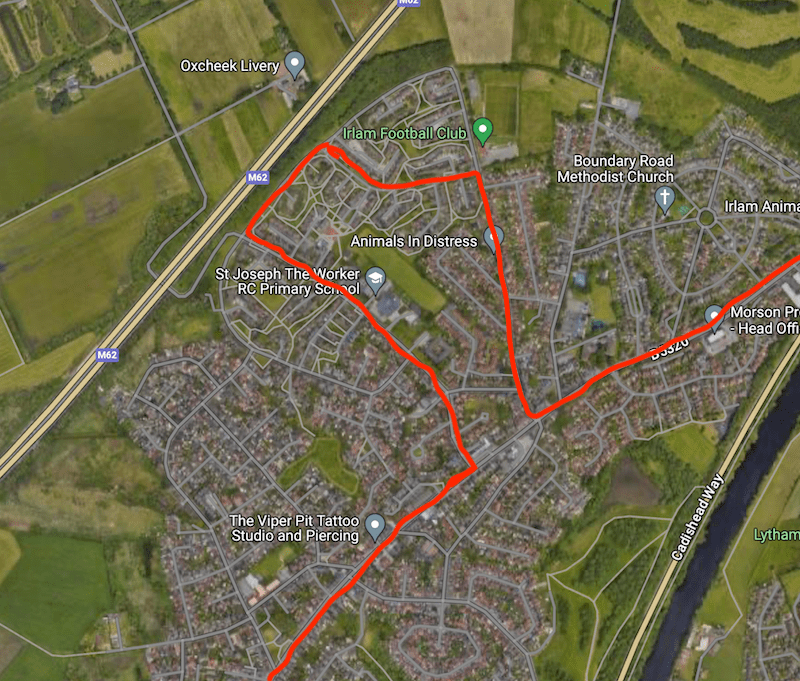
The roads have narrowed and it no longer feels like an inter-urban route…

… not least as we get held up for a couple of minutes while a refuse lorry makes a special collection.

Once that was sorted we’re soon back on the A57 before turning off to duck under the M60, cross over the Manchester Ship Canal …

…and arrive at the nearby mega size Trafford Centre two minutes ahead of schedule at 09:52 for a layover of six minutes.
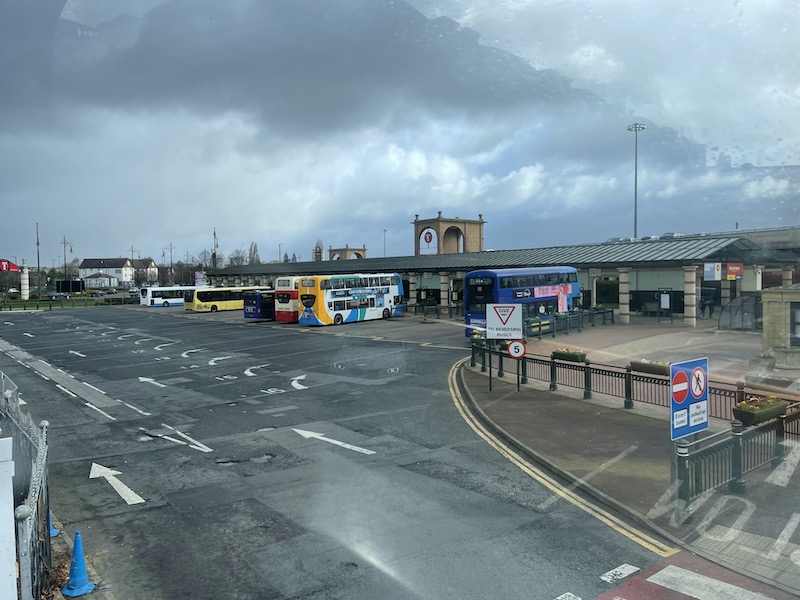
I decided to get off for a short break and wandered into the shopping centre to have a quick explore and a toilet stop.

I was back in the bus station 10 minutes later and the very same bus I had come in on was still on the bus stand so jumped back on and we left, two minutes late, heading off towards Manchester.
The route gets busier as it passes through Eccles and Salford and 40 minutes after leaving the Trafford Centre we pull into Manchester’s uninspiring Shudehill Interchange where a dozen of us alight, the bus turned into a 67 for its next journey and I go in search of a new timetable leaflet as already described.
See earlier paragraph.
After leaving the Travel Office I spotted the notice photographed below advising passengers that the last two journeys to Warrington (at the old times of 16:47 and 17:47) are only going as far as Cadishead until 21st April.

That means the last through journey on the new timetable is presumable the 15:30 departure (assuming the newly timed 16:30 and 17:45 departures from Manchester are similarly curtailed for whatever the same unexplained reason for this draconian measure is).

Intrigued about what could be causing this disruption I took a look at the Bee Network website and naturally clicked on ‘Travel Alerts’ entering bus route 100 only to find no mention of the issue at all. Just a reference to the departure stand changing at Shudehill Interchange.

Undeterred I tried entering a journey into the Journey Planner. It recogised Sudehill Interchange but had never heard of Warrington Interchange referring me instead to places in Fareham, Knutsford or Wigan.
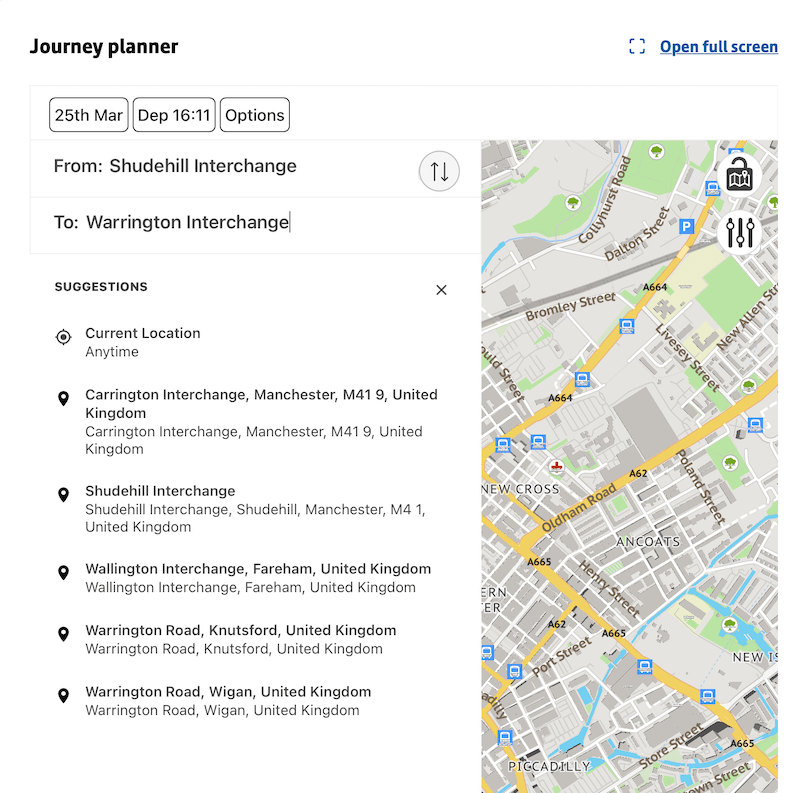
I should have known to enter Warrington Bus Station, which it did recognise. ‘Interchanges’ are only good enough for TfGM it would seem. Everywhere else has a bus station even if Warrington calls its bus station an Interchange.
And still everyone reckons Journey Planners are the answer to everything. The result was to send me on a V1 to Leigh and change to the 19 back to Warrington as an alternative to the disappearing-without-explanation 100 journeys.
Social media messages from TfGM have been extolling the improvements in punctuality achieved since painting buses in the Bolton and neighbouring areas yellow since last September. Apparently the paint has a special punctuality achieving ingredient, so once the former First Bus, then Go North West, now Stagecoach operated buses receive their magic yellow paint makeover passengers on route 100 will be excited to know they’re part of that coveted ‘world class’ bus network we hear so much about from Metro Mayors.
Roger French
Did you catch the first six ‘Every route 100’ blogs? Here’s 1 of 26 (Stevenage-Hitchin) 2 of 26 (Crawley-Redhill), 3 of 26 (Lincoln-Scunthorpe), 4 of 26 (Glasgow-Riverside Museum), 5 of 26 (Campbeltown local), and 6 of 26 (Guildford’s Onslow Park & Ride).
Blogging timetable: 06:00 TThS including an extra Easter Sunday blog tomorrow.
Comments on today’s blog are welcome but please keep them relevant to the blog topic, avoid personal insults and add your name (or an identifier). Thank you.


Nice review, thank you. It’s a route I enjoyed driving, especially when it included the Warrington section.
However, it’s not ‘Sudehill’ but ‘Shudehill’.
LikeLiked by 2 people
Many thanks for spotting that. Now corrected.
LikeLike
I’ve used this service a few times but not since covid, back in the day it was the 10 Warrington-Manchester but on a more direct route between Eccles & Warrington.
The 100 started when the Trafford Centre opened, was originally 100 Manchester-Trafford Centre via Pendleton & Eccles, First Manchester then diverted the 10 to operate via the Trafford Centre, before merging the 10 with the 100 to become today’s route.
SM
LikeLike
Thanks for bringing back happy memories of driving LUT Guy Arabs between Manchester and Warrington on what was then the 10. It was always one of my favourite routes, although in those days we were spared the delights of the Trafford Centre and the termini at either end were rather more primitive than the current “interchanges” (Although the LUT crews always considered the Crosville canteen at Warrington a step above ours at Swinton!
Jim Davies
LikeLiked by 1 person
Your writing has particularly sour grapes around the controversial franchising system. Yes, not fabulous that a future timetable was unavailable. But any timetable at all being available is in the minority of private sector operations. And while their simple design may not inspire new customers, people within a bus station have generally already committed to their mode of transport and clear, functional information is preferable.
Frequency increases on both the 100 and 67 are glossed over in your writing as if it would have happened regardless. A simple search of ‘Warrington A57 Road closure’ brought up the roundabout works which explain the 100’s curtailment.
It’s not a perfect system by any stretch, but as I understand it, franchise bids have come in under budget, fare revenue is above expectations and punctuality has improved. It is illogical that ‘painting a bus yellow’ achieves all of these things, but the results are there. Bee network has achieved public engagement with ‘the bus’ leaps and bounds over what the private sector ever could. They’re hardly perfect, but there’s a civic pride emerging behind Manchester’s yellow buses, which can’t otherwise be bought.
There are small gems of excellent commercial bus operation in the UK, but they are lost in a sea of mediocrity from the majority. I yield to your vast knowledge of bus operations and I found your recent web seminar very interesting, but I can’t see how there’s any life left in commercial bus networks without disproportionate public funding, by which point the benefits of a public ‘controlling mind’ do start to stack up.
LikeLiked by 1 person
Someone, apart from Roger, should try keep the late Professor John Hibb’s legacy alive (whilst there are still some pockets of entrepreneurial space left in the UK bus ecosystem)! I think that whilst the point made by ”Anonymous” about civic pride might have some validity (somehow, we felt a tad of such in the era of Selnec/GMT), I do believe that even the pride and trust that the public invest in the NHS is being tested of late – with, for example, the widely transmitted news story this week about excessive wait times in A&E potentially being a contributory factor in some bad outcomes for the public. And regarding the point made that there are only ”small gems of excellent commercial bus operation that are lost in a sea of mediocrity”, I believe that we should remind readers of John Hibbs’s key point that the market for commercial bus services should be ”contestable” (with, even the mere threat of competition serving to keep incumbent operators on their toes). But it is this ”contestability” that has been much impaired in recent times, perhaps due to the ”Sword of Damocles” effect that hangs above the risk capital of any new-entrant innovator (whereby the threat of re-regulation way exceeds the threat of any additional healthy competition!). Anonymous II
LikeLike
John Hibbs and any other protagonists for deregulation have been proven, perhaps sadly given the damage done to public transport in England, Wales and Scotland, demonstrably badly wrong about the benefits of such a system. Publicly planned bus networks either franchised or directly owned are not a guarantor of excellent public transport but they are a prerequisite. Just look at almost any city in Europe. Look at the inter urban and rural networks in Switzerland, South Tyrol, Czechia or Belgium and increasingly Ireland. The proof is overwhelming. Manchester will succeed so long as it has decent management and fair resources.
MikeC
LikeLike
I am sorry. I grew up in the 70s. The public sector operated services of the era were not great. In my home town, frequencies on key routes are more frequent (for example) than they were then. Deregulation has not been an unmitigated success but what it replaced was not so great either. Let’s see how successful politicians will be in delivering a better service over time. I am sceptical.
LikeLike
Shudehill please!
LikeLike
The temporary reduction in evening services appears to be due to road works: Warrington’s Own Buses have this recorded on their website for their evening service 3 which recently was extended to Hollins Green to link to the 100
3 – Warrington – Martinscroft | Warrington’s Own Buses (warringtonsownbuses.co.uk)
LikeLike
To add, the GM area often has paper timetables published & stocked from the change date onwards & not before [even if the change date is the following day], so nothing new, & nothing to do with franchising either, GM however, is still one of the few areas left that still publish paper timetables for most if not the whole network, Merseytravel for instance stopped publishing their paper timetables from 2019
SM
LikeLike
So Franchise bids under budget! Was the budget correct and are the bids sustainable over a 5 year period? Revenue above expectations , in our area revenue is 20% above last year so if they are not that amount ahead of their ‘budget’ then they are lagging behind. Punctuality has improved, if their are using BODS then there are lies, damn lies and BODS.
However I think we should suspend judgement on the Bee Network until it’s settled down, it’s costs become transparent, as they have been well hidden so far, and all of this delivers improvements in patronage .
LikeLike
I’ve read all your current blogs around the route 100. You have stated there are only 26 but I’ve found 54 on bus times, meaning you are ignoring the remaining 28.
LikeLike
If you bother to actually look at the list on Bustimes you’ll see that most of the rest aren’t even 100s.
Then some that are 100s are school services and at least one is in the Republic of Ireland.
LikeLike
Manchester’s (GMPTE in the days I remember) timetable (printed and roadside) has always been “functional” rather than (generally) inspiring. Maybe it is the typeface, Are the trams going the Bee Mustard Yellow as a livery? – not sure If I like it). There had been long campaigns to turn the bus network back to the “muncipal” days of ownership – mostly by younger persons whom seemed to have forgotten the likes of LUT and North Western operating into the SELNEC area. Bus reliability probably has improved – First/Diamond and to a lesser extent Go did seem to have problems with sticking to timetables pre covid. In part if they dont have to worry about revenue for themselves resources can be put in place for driver availability and keeping vehicles maintained and ready for service . It is interesting that as well as the next tranche of franchising proceeding from the following day, there were also increases in other services from the earlier one , part as post covid enhancements restored, part as a result of passenger statistics and part as a bit of try it and see, the latter has the problem of will the extra cost of service supply (which may be as little as a bit extra drivers hours, fuel and tyres or as much as a whole new bus, two new driver shifts ) be covered by the additional passenger revenue ? Manchester seems slightly better than London at matching road space to buses – not being a seat of government and an international capital probably helps . The 100 seems like a route that might not (unless you really are looking to save money) see many through end to end passengers, being more of a continual sweep up of passengers that might take another route to their intermediate or final destination- certainly within the Manchester Area. IF a new timetable is not significantly altered on normal first and last buses and the half hourly or less sections have not moved times beyond +- 5mins then as the intermediate frequencies have been increased it is not too much of a hardship not to have timetables available in advance- perhaps though advance advertising from say a week ahead of the new times with a leaflet for times and route may have been useful and indeed generate more bus use.
JBC Prestatyn
LikeLiked by 1 person
This is, sadly, possibly the bitterest diatribe I’ve ever seen you write, Roger.
Given your tendency to be partisan, has one of your chums been shifted out of a cushy role or has your mate Ray lost a major contract?
Whatever the reason, it’s beneath you to behave like this.
LikeLike
I’m afraid i have to agree. There have been a couple of articles recently where you’ve come in with an ‘I already don’t like this, so let’s pick at things and be petty’ mentality. This one, though, was blatantly in this camp and it just came over as an angry, sarcastic rant.
The privatised bus world doesn’t work anymore, on the whole. I grew up in Sheffield in the 70s and 80s and really despair at the state of things there now. South Yorkshire wants to look into franchising too. I wish them the best of luck because the commercial model has run things into the ground.
LikeLike
Both commercial and public ownership can work; equally there are too many instances where neither work. Roger is right – just changing the colour is no guarantee that things will be better. If I learned anything after 45 years on the buses it is that what works is stable management, and motivated people right down to the driving and maintenance staff.
After all, what most impacts day to day reliability is staff commitment (or lack of it) at a depot level, and I guess that the same people are at, say, Manchester Queens Road after the change of ownership. Constant change will not help their interest in getting a full and timely run-out done or going the extra mile when problems have to be faced.
Anthony Holden
LikeLiked by 1 person
Warrington’s bus stops are very poor. They list services that went many year’s ago! I don’t think the council there updates them any more. TfGM’s have always been a lot better
LikeLiked by 1 person
I have not seen any statement from TfGM that bids for the Bee Network came in under budget. They do say revenue is over budget but in the Bee Network Performance Report to GMCA Bee Network Committee on 21 March (this is available on the Greater Manchester Combined Authority web-site) they say that costs are above budget, which is offsetting the higher revenue. They do not say why this is and none of our elected representatives on the committee asked that key question.
A. Henthorn Stott
LikeLiked by 1 person
Its Rogers blog and I think he can be as partisan as he likes, given his immense experience. For the Bee Network bids were below budget, and revenue is 24% above budget, but so are costs. As costs are bids plus the cost of Tfgm overseeing the whole thing, it means that TfGM’s own costs are way over budget.
This is typical of when a state run organisation is allowed to hide costs, as has happened so far with the Bee Network costs are out of control.
Rogers cynicism may be well founded.
LikeLiked by 1 person
I’m not sure how the Journey Planner could recogise – or even recognise – Sudehill when it’s Shudehill. Also, Banksby???
LikeLike
You write, Roger:
Have you thought of a blog on deviant bus routes?
In Cambridgeshire, Stagecoach East’s Busway route B is the weirdest. From the city it travels in a direct route to Cambridge North Station (CMB) then fast on the Busway to St Ives. From St Ives too Huntingdon, buses take a scenic tour of St Ives’ housing estates and those to the east of Huntingdon. See the map here.
Hence the journey time from St Ives bus station takes 38 min to Huntingdon Bus station (approx 15 min by car using A1123 and B1514, say 20 mins for a limited stop express bus) and an additional 15 min to Hinchingbrooke Hospital (approx 5 min by car using A1307 and B1514, maybe 8 mins for a limited stop express bus). See timetable, here.
LikeLiked by 2 people
Those are some route wiggles to behold!
LikeLike
Who would have thought it, bus routes that go where people live and connect them to their local centres.
How many people want to go from St Ives town centre to Huntingdon town centre?
LikeLike
How many passengers want to go to/from Cambridge centre to the Oxmoor estate?
There is a case for a direct route St Ives – Huntingdon Bus Stn – Huntingdon Rail Stn – Hinchingbrooke Hospital. And local routes around the housing estates connecting to Huntingdon Bus Stn, St Ives Bus Stn, St Ives P&R.
The suspicion is that the route was ‘historic’ (ie inherited from a BTC subsidiary by an NBC subsidiary, then by by a Stagecoach, then Huntingdon & District, then back to Stagecoach) with the Busway kinda added on, without too much thought to route development, ridership uplift…
LikeLike
In my experience of the Busway services, quite a few seem to board in Oxmoor heading towards Cambridge, similarly from the St Ives estates. Most people don’t live in the town centres, that is where they are going so buses running via the areas of housing on their route is a logical thing to do. The Busway route is a sensible amalgam of 3 different overlapping routes (a Huntingdon local service: Oxmoor-Town Ctr-Stn & Hosp, the local rural service: St Ives-Huntingdon-Stn & Hosp & the interurban Huntingdon & St Ives to Cambridge) serving all markets with probably half the resource and given the loadings and pre-COVID passenger growth it has clearly worked.
The Huntingdon to St Ives corridor was completely redesigned for the Busway and what exists now is completely different to that which existed prior. Pre-Stagecoach Cavaliar/H&D ran 3 buses per hour from Huntingdon via St Ives to Cambridge each following a different route & serving different places (1 via Oxmoor, 1 via RAF Wyton & 1 via Houghton) though all did the diversion via northern St Ives & none ran to Hinchingbrooke Hosp & only peak trips went to the station plus Whippet ran a slightly irregular service also between St Ives & Huntingdon (largely hourly by a different combination). Oxmoor also then had a multitude of different local services running different routes round the estates at lowish frequencies meaning it would have been a complicated task for local residents to work out what their service was. In preparation for the Busway Stagecoach simplified this network into a standard 3-jnys per hour timetable following the same route on all trips so the timetable was simpler and easier to follow (though not necessarily everyone actually having more journeys in total) which has been enhanced since due to passenger growth.
The busway corridor is certainly not a historic structure dating back to nationalisation era (or earlier) but a newly designed network for the Busway opening based on experience of the actual demand at the time it was proposed.
Dwarfer
LikeLike
Sadly dilapidated bus stops and shelters and lack of timetable information tends to be the norm
LikeLike
Helpful as it is to show routes on the OS map, is the version used copyright-free?
LikeLike
interesting article.
The 100 has always fascinated me as it seems so convoluted, from the Irlam spur, which was previously done by the 67 to the Trafford Centre deviation.
It seems to me that it would be better run as two routes, ie, Warrington to Trafford Centre and another service running the Trafford Centre to Manchester City centre and the Irlam spur being returned to route 67.
LikeLike
I grew up in South Manchester in the 70s and 80s and bus 100 ran from Woodhouse Park via Southern Cemetery, Princess Road, Moss Side and onto Manchester Arndale bus station. The route disappeared during the 1986 deregulation debacle and obviously the number was going spare, hence why it’s now used on this route. Even after all these years, I still think of any bus starting with 10 as a bus that should be running down Princess Road as services 100 – 109 used to do back in the day.
LikeLiked by 1 person